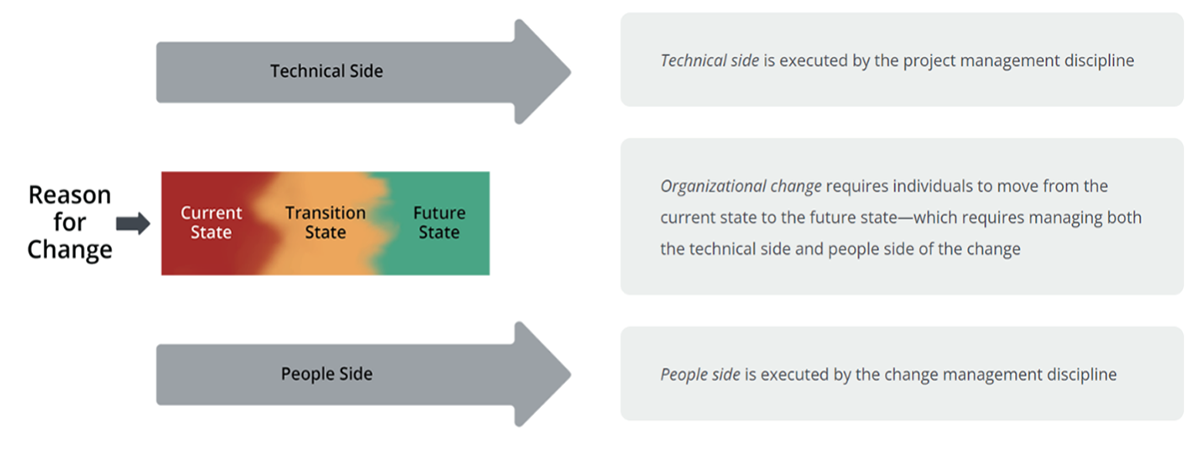28 July at 07:00AM
Change Management in an Agile Environment

Change is challenging; however, organizations must continuously change and evolve to succeed. Many organizations struggle to achieve desired results, outcomes, and value, even after delivering the requirement on-time and within budget. Too much focus is put on the technical aspects of the change. For a successful transition, organizations must also focus on the people-side and ensure that each individual embraces and adopts the change. Agile is an iterative approach to project management. Agile uses iterative development cycles to improve change outcomes. On the other hand, change management helps to identify those unique patterns in how humans within organizations implement change. Change management drives employee adoption and usage of solutions to improve change outcomes.
On April 13th, PMI Toronto's Agile Community covered the topic of Integrating Agile and Change Management. The event's guest speaker, Tim Creasey, looked at the foundation of change management and agile and how they can be integrated to achieve a successful project outcome. Mr. Creasey discussed the research Prosci has done to help elevate the understanding of these two disciplines and the steps that can be taken manage change adoption in an agile initiative while increasing project success.
Meet Our Guest Speaker
Tim Creasey is the Chief Innovation Officer at Prosci. He is also an author, researcher, and change expert. Tim’s work forms the foundation of the world’s largest body of knowledge on change management and he focuses on the people side of change with process, wit, and vigour.
Bringing Together Change Management and Agile
Change has two sides: technical and people. Change is about moving out of a current state and transitioning into a future state. The current state is how things are done today. It's known, it's comfortable, and the future state is what is desired more for the organization. Every change begins with a reason. Sometimes it's competitive pressure, technological pressure, etc. But every change has a cause, and every change has a technical side where we design, develop, and deliver a technical solution, and a people side where we help our people engage, adopt, and use solution efficiently. When these two things come together, we deliver successful outcomes.
Agile provides an iterative approach for managing design, development, and delivering technical solutions. Change management emerged as the discipline to help execute the people side of the project: how to help people engage and adopt. Change management is the enabling framework for managing the people side of change. The organization only changes when the individuals bring the shift to life. Organizational outcomes are the collective result of individual differences.

Prosci’s Research: Best Practices to Incorporate Change Management in an Agile Initiative
Prosci has been conducting in-depth change research for more than 20 years. The main objective of their study is to uncover and identify challenges, lessons learned, tips, and suggestions for practitioners working to bring iterative development into their organizations and help drive better adoption and usage of those solutions. They have studied many aspects of managing change more effectively in an agile initiative. Based on the research outcome, they have created the Prosci methodology for change management to support individuals transitioning from the current state to the future state. This approach leads to successful project outcomes. As per Prosci the greatest contributors to success in an Agile environment are:
1. Early engagement of the change manager
2. Consistent communication
3. Senior Leader engagement
4. Early wins
Adaptations for Agile Project
Change management in an agile project is very different than a traditional waterfall project. Agile change management unites the change management activities with the incremental delivery from each sprint and increments of agile development. The frequency of change generated by agile approaches means that the traditional change management activities must speed up. Flexibility is key here:
1. Change management becomes iterative.
2. Change management plans becomes living documents
3. Change management requires more upfront work
4. Change management needs to be done in less time and at a faster pace
Core Roles in Change Management
A project can only be successful if every employee adapts to the change—this is the soul of change management. To manage change successfully, all core roles must participate. This is similar to putting on a play where change practitioners, sponsors, people managers, project managers, and impacted employees engage with the change and coordinate their efforts accordingly. From the highest levels of leadership to front-line employees, an entire group of people within the organization must support employees throughout the transition.
Adding proper integration of agile and change management into your organization can create better project outcomes.




